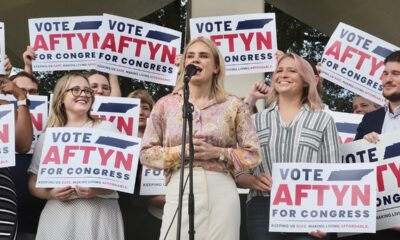California
Election 2024: Get to know the candidates in California’s 38th congressional race

There’s a bit of a rematch happening in California’s 38th congressional district.
Rep. Linda Sánchez, a Democrat from Whittier who is serving her 11th term, is being challenged by Walnut City Councilmember Eric Ching, pastor John Sarega and entrepreneur Robert Zhang Ochoa. She faced Ching and Sarega in the midterm election in 2022.
Sánchez’s seat is deemed unlikely to become closely contested by the Cook Political Report, which analyzes elections. According to state data, Democrats account for 48.3% of all the registered voters in the district, which covers portions of Los Angeles and Orange counties, while 22.8% are no party preference voters and 22.7% are Republicans.
Ching, Ochoa and Sánchez differ on several issues, including immigration. Sarega did not submit a questionnaire for the Register’s 2024 Primary Election Voter Guide and did not respond to requests for comment about his platform.
Sánchez, the daughter of immigrants from Mexico, is a strong advocate for a pathway to citizenship for “Dreamers,” young immigrants brought to the U.S. unlawfully, as well as agricultural workers and noncitizens who have temporary protected status, which is granted to foreign nationals from countries that have “extraordinary and temporary conditions,” like war, that prevent them from returning safely, according to U.S. Citizenship and Immigration Services.
She also supports reforms to the United States’ asylum system, which include increasing asylum processing, upping the number of refugee and asylum officers and expanding temporary shelters for asylum seekers, as outlined in legislation she introduced last year.
“The U.S. Citizenship Act would build upon existing funds to provide smarter and safer border management, specifically by directing new resources to where they are most needed — at ports of entry where we must invest in technology, infrastructure and screening capacity,” Sánchez said.
But Ching and Ochoa, both Republicans, suggest shutting down the border.
“We should stop people from coming in because our cities cannot handle more illegal immigrants,” said Ching, who came to the U.S. from Taiwan in 1982. “We should not have any more people that we can’t handle.”
As for “Dreamers,” Ching said it isn’t fair for them to get “a free pass” simply because they were brought to the U.S. by their parents through no fault of their own.
“For the young kids, it’s not their fault,” Ching said. “But I do believe that we have to have law and order.”
Ochoa, who immigrated to the U.S. from Mexico when he was 6, said the border “needs to be closed.” He’s also advocating for reinstating the “Remain in Mexico” policy, which requires asylum-seekers to wait in Mexico for their hearings, and a guest worker program, formerly known as the “Bracero Program,” which, from 1942-1964, allowed millions of Mexican laborers to work in the U.S with a temporary work permit.
“That worked really well … they were here legally,” he said. “They had the right to be here for a period of time to work, and then they had to go back and reapply. My dad and all his friends would do that constantly, and it worked well for everybody. The United States needed workers and people from Mexico would take their earnings back home, so everybody was happy.”
Ochoa also said he supports a pathway to citizenship for “Dreamers.”
“That’s a very easy answer, yes,” he said. “I came here legally with paperwork, but in my mind, I always think, ‘Suppose my parents had not come here legally. I didn’t have a choice, I was 6 years old. I lived here my entire life.’”
CA-38 has the highest unemployment rate, 4.4%, of all the congressional districts that touch Orange County, according to U.S. Census data, The district includes La Habra in Orange County and Diamond Bar, La Habra Heights, Hacienda Heights, La Mirada, Los Nietos, Norwalk, Montebello, Pico Rivera, Rowland Heights, Santa Fe Springs, Walnut, Whittier and parts of Downey and Industry in Los Angeles County.
Sánchez strongly supports union workers and higher wages, and her political philosophy involves advocating for the working class, she said. Ochoa wants to see the economy improve, and Ching says that “the net effect of any bill should be beneficial to both the labor and employer as a whole.”
“Higher wages drive up the cost of living,” Ching said. “So by raising their minimum wage, is that really a win-win for the employee?”
Just as labor was one of the hottest topics in the California news landscape in this election cycle, foreign conflicts, including the Israel-Hamas war, are a driving topic in 2024 as well.
When asked how much assistance should the U.S. provide — military and/or financial — to foreign countries at war, like Israel or Ukraine, Sánchez said: “It’s critical that we deliver already-delayed aid to Ukraine in their efforts to stop Russian aggression and deliver aid to Israel as it works to defend itself from Hamas.” Aid to Ukraine and Israel has been delayed due to Congress’ inability to reach a deal yet this year on granting billions of dollars to the war-torn countries.
Sánchez also said humanitarian assistance must be delivered to “the millions in Gaza who are without food, water, fuel and more.”
“When it comes to assistance from the U.S., we have a responsibility to ensure humanitarian needs are met and that any military offenses are done within the bounds of international law,” she said.
While Ching and Ochoa agreed that the U.S. should aid its allies, Ching believes the assistance should serve “our national interests,” and Ochoa says the U.S. should ensure “other countries contribute a proportional amount of assistance.”
“For example, if Taiwan is at war, there are friendly countries like South Korea, Japan (and) so forth that should be contributing financial support,” Ochoa said.
If those countries decline to give money, the U.S. needs to exert pressure on them by saying the U.S. may not give them financial support if they’re ever in trouble, he said.
In terms of the money game, Sánchez is far and away in the lead. She reported raising $217,035 in the last quarter of 2023, ending the year with $628,948 still left to spend.
Ching reported raising $1,390 and having $10,517 cash on hand.
Sarega and Ochoa haven’t reported any fundraising.
Primary ballots are set to go out to all registered voters on Monday, Feb. 5. Ballot drop boxes will open the same day and voting centers will open starting Feb. 24. The Orange County Registrar’s office will provide in-person voting, voter registration, replacement ballots and other general assistance starting Feb. 5.

California
Average Thanksgiving dinner cost was higher in California than most of US: Study

If you noticed your grocery bill for Thanksgiving staples was more expensive this year, it may be because you live in California, according to the American Farm Bureau Federation.
A new study by the federation shows that Californians were expected to spend more on traditional Thanksgiving dinner ingredients in 2025, according to its 40th annual Thanksgiving dinner survey. Its data showed that a classic Thanksgiving dinner for 10 people in California costs $72.61 compared to the national average of $55.18.
Shannon Douglas, President of the California Farm Bureau, said that expenses for what goes into agriculture production in the Golden State are to blame for the disparity.
“We think that’s a couple of things in play. No. 1, it does cost more to grow food here in California,” Douglass said. “In California, we have the toughest regulatory environment, really, in the country. We have some of the highest labor costs. We know that just regulatory costs alone, for some growers, is about $1,600 per acre; That adds up, of course, very quickly. And in California, we’ve got some of the highest transportation costs, the highest energy costs. Much like so much of the other things in California, it just costs more here.”
According to Douglass, the bureau’s findings aren’t completely bleak for residents who live in the Golden State. The holiday dinner’s centerpiece was cheaper in California in 2025, she said.
“Turkey, actually, was down, which was a helpful one, and interestingly enough, stuffing is less expensive,” Douglass said. “… But most of the other products were up, particularly like the dairy products in California were a little bit higher.”
In addition to overall costs being more expensive in California, the reduced labor force has also posed a challenge and contributed to the increase in costs.
“We have lost a lot of farmers in California because of this tough regulatory environment that we’ve been forced to navigate,” Douglass said. “In the last 10 years, we’ve lost about 20% of the farmers in the state, and that’s significant, of course. Unfortunately, we’re one of the leading states in the country in farm loss … so, we certainly have that as a challenge.”
According to the American Farm Bureau Federation, the average cost for a classic Thanksgiving dinner for a party of 10 by region was:
- West Coast – $61.75
- Midwest – $54.38
- Northeast – $60.82
- South – $50.01.
Still, the California Farm Bureau acknowledged that the average cost in California was significantly higher than in the West Coast region.
To read The American Farm Bureau Federation’s 40th annual Thanksgiving dinner survey, click here.
To read the California Farm Bureau’s study, click here.
California
Why Southern California’s most vulnerable youths face hunger during school holidays

The holidays are a time when people gather with loved ones and celebrate abundance, but when California’s most vulnerable young people aren’t going to school because they are on break, it means even more uncertainty over where to find food. And that leads to even greater risk.
That’s the finding of a coalition of Orange County nonprofits that is tracking 500 at-risk youths to better understand what they need to live more stable lives and steer clear of abusive situations.
The collaboration uses a new tool for digital case management, research and prevention, developed by EverFree, which supports human trafficking survivors, in partnership with UC Irvine. It allows the nonprofits to collect information from young people, ranging from those in elementary or middle school to 24-year-olds.
Almost half the students tracked with the digital tool, who were referred by social-work case managers, said they aren’t living a healthy lifestyle, the nonprofits said. One in 5 said they often don’t know how they’ll eat and one-third said they struggle with mental and emotional well-being.
All of the participants come from families that are either unhoused, living in temporary housing such as motels or sharing crowded dwellings with multiple, unrelated families, said Shelby Feliciano-Sabala, a social worker who is chief partnership officer at Project Hope Alliance, a nonprofit that helps children experiencing homeless. The organization is working on the project with EverFree and Stand Up for Kids Orange County.
School can be much more than a place to learn, Feliciano-Sabala said.
“Youth experiencing homelessness get a sense of belonging, safety and routine when they’re at school,” she said. “When you don’t have that routine, and you don’t have access to that food, that disrupts your regular life.”
When already-vulnerable youths undergo even more uncertainty about getting food, there is often someone waiting to exploit that situation by luring them into coerced labor and sex work or subjecting them to gender-based violence, said Kelsey Morgan, co-founder and chief executive officer of EverFree.
“We’ve heard stories from many of our other partners of youth who run away and are approached by a trafficker who simply offers a McDonald’s cheeseburger,” Morgan said.
Feliciano-Sabala said she’s heard of traffickers winning over young people with a gift as meager as a bag of Takis rolled tortilla chips.
“Food insecurity is actually resulting in runaway situations where kids are so desperate that any person willing to offer them something small is winning their trust,” she said.
Feliciano-Sabala said private nonprofits represent “critical infrastructure” all year round, but particularly during the holidays, when the need tends to spike.
For families living in their cars, for instance, her nonprofit distributes gift cards to restaurants where they can eat in more comfort and safety, she said. Families staying in hotels with nowhere to cook can receive prepared food such as turkeys and tamales. Her nonprofit also distributes food from its small pantry or buys groceries for families in need.
Inadequate food is an ongoing problem for young people and families across California and the U.S., and it’s not only school-age children who are at risk.
One in 4 college students nationwide has an unreliable food situation, according to an analysis by the nonpartisan U.S. Government Accountability Office, which provides fact-based information to Congress. However, most of those who are potentially eligible are not enrolled in the federal Supplemental Nutrition Assistance Program — or SNAP — the GAO found.
Congress passed a law in 2024 designed to raise enrollment in federal food-aid among students by giving the U.S. Department of Education the authority to share student data with both federal and state SNAP agencies to determine their eligibility. But in a report this year, the GAO said that the department still had not made a plan to share this data, or given states guidance about the benefits of the law.
Self-assessments completed by young people ages 18-24 in Orange County as part of the nonprofits’ data collection mirror the food-access concerns that young adults across the country report. The research shows about half go to an institution of higher learning full-time, a third go to school and work part-time and the rest work full-time. So even though they have income, many are worrying about food, Morgan said.
In fact, getting enough to eat ranked higher than adequate clothing and safe, stable housing among college-age students who shared their top priorities ahead of the holiday season in 2024, she said. The nonprofits plan to release more insights about youths they’re tracking in 2026.
“When you look to the data of what these youth are asking for, it sheds a lot of light on what those core vulnerabilities are,” Morgan said. “These are individuals who want, desperately, dignified employment. They’re prioritizing things like savings, household income, money management, skills for employment and healthy lifestyles.”
Feliciano-Sabala said the digital tool was developed in response to the desire among case workers to offer help that is more tailored to those in their care.
The nonprofits hope to share their findings with service providers and policymakers to better address what young people say about their lives and dreams.
California
Letters to the Editor: Small pieces of trash litter California’s beaches — and even those harm animals

To the editor: It is horrible that even very small pieces of plastic trash harm marine animals (“How little plastic does it take to kill marine animals? Scientists have answers,” Nov. 17). Having picked up trash at Oceano Beach and Pismo Beach for years, I’ve seen flattened mylar balloons (in the most remote places), ubiquitous cigarette butts, toothpick wrappings, plastic grocery bags, bottle caps, degraded plastics of beach toys and Styrofoam. These items are easily found in kelp piles, along with white foam beads and hard plastics in a variety of colors.
I am grateful to the SeaVenture Beach Hotel for holding monthly Pismo Beach cleanups and to Taylor Lane of the “Cigarette Surfboard” documentary, who has made it a cause to stop plastic pollution.
Mark Skinner, Los Osos
-

 Science7 days ago
Science7 days agoWashington state resident dies of new H5N5 form of bird flu
-

 News1 week ago
News1 week agoAnalysis: Is Trump a lame duck now? | CNN Politics
-

 World1 week ago
World1 week agoPoland to close last Russian consulate over ‘unprecedented act of sabotage’
-

 World1 week ago
World1 week agoZelenskiy meets Turkish president as word emerges of new US peace push
-

 Business4 days ago
Business4 days agoStruggling Six Flags names new CEO. What does that mean for Knott’s and Magic Mountain?
-

 New York1 week ago
New York1 week agoDriver Who Killed Mother and Daughters Sentenced to 3 to 9 Years
-

 World1 week ago
World1 week agoUnclear numbers: What we know about Italian military aid to Ukraine
-

 Politics1 week ago
Politics1 week agoMamdani keeps Jessica Tisch as NYPD commissioner





















